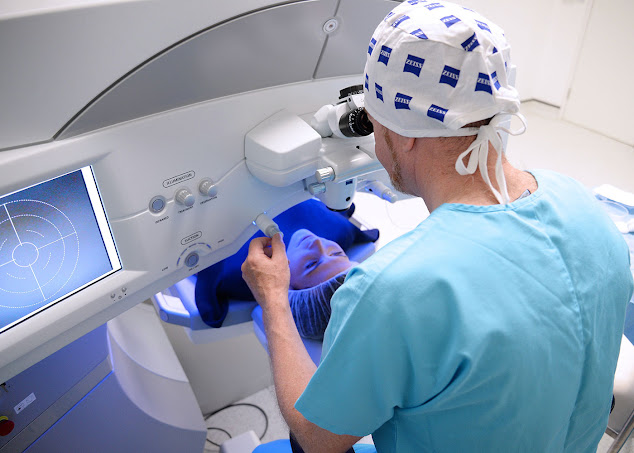Laser eye correction is revolutionising the landscape of vision correction in the UK, providing a transformative solution for people seeking help with their vision problems. With advancements in laser technology such as LASIK, SMILE, and PRK, patients now have access to highly precise and safe procedures that can effectively treat common refractive errors like myopia, hyperopia, and astigmatism. These procedures offer the possibility of clear vision without the dependence on glasses or contact lenses, giving patients greater freedom and convenience in their daily lives. My-iClinic based in London UK is a leader in cutting-edge diagnostic equipment and personalised care approaches, ensuring tailored treatment plans that optimise outcomes and safety for each individual. As a result, laser eye correction has become a preferred option for many, helping to enhance quality of life and redefine what is possible in vision care today.
LASIK Laser Eye Correction
LASIK (Laser-Assisted In Situ Keratomileusis) is one of the most popular and effective types of laser eye surgery for vision correction. It involves creating a thin flap in the cornea, the transparent front part of the eye, and using a laser to reshape the underlying corneal tissue. This reshaping corrects refractive errors such as myopia (nearsightedness), hyperopia (farsightedness), and astigmatism, allowing light to be properly focused onto the retina for clearer vision. LASIK is a suitable option for those who want to reduce or eliminate their dependence on glasses or contact lenses, providing long-lasting results with minimal downtime. The procedure is quick, typically taking only 15 minutes for both eyes, and most patients experience a significant improvement in vision within 24 to 48 hours. Statistically, over 95% of LASIK patients achieve 20/20 vision or better, while 99% achieve at least 20/40 vision, which is sufficient for most daily activities, including driving without corrective lenses. These high success rates, combined with the safety and convenience of the procedure, make LASIK a compelling choice for anyone looking to improve their vision and enhance their quality of life.

SMILE Laser Eye Correction
SMILE (Small Incision Lenticule Extraction) is a modern and minimally invasive laser eye surgery option for vision correction, particularly suited for those with myopia (nearsightedness) and mild astigmatism. Unlike LASIK, which requires creating a flap in the cornea, SMILE involves using a femtosecond laser to create a small, lens-shaped piece of tissue (called a lenticule) within the cornea. This lenticule is then removed through a tiny incision, reshaping the cornea and correcting the refractive error. Because SMILE does not involve a large corneal flap, it preserves more of the corneal structure and results in faster healing, less dry eye, and a lower risk of complications related to the flap. The procedure is quick, typically taking less than 15 minutes, and most patients experience significant improvement in vision within a few days. Statistically, SMILE has a success rate similar to LASIK, with over 90% of patients achieving 20/20 vision or better and around 98% reaching at least 20/40 vision, suitable for most daily tasks. With its minimally invasive nature, reduced risk of side effects, and high satisfaction rates, SMILE is an excellent option for those seeking a safe and effective way to correct their vision without the need for glasses or contact lenses.

PRK Laser Eye Correction
PRK (Photorefractive Keratectomy) is one of the earliest forms of laser eye surgery for vision correction and remains a highly effective option for treating myopia (nearsightedness), hyperopia (farsightedness), and astigmatism. Unlike LASIK and SMILE, PRK does not involve creating a flap in the cornea. Instead, the outer layer of the cornea (the epithelium) is gently removed to expose the corneal tissue underneath. A laser is then used to reshape the cornea, allowing light to properly focus on the retina, thereby correcting vision. The epithelium naturally regenerates over a few days after the procedure. PRK is particularly suitable for individuals with thin corneas, dry eyes, or those at risk of eye trauma, such as athletes or military personnel, because it avoids the risks associated with flap creation. While the recovery time for PRK is longer than that of LASIK or SMILE, with full visual clarity developing over several weeks, the outcomes are equally favourable. Statistically, around 90-95% of PRK patients achieve 20/20 vision or better, and approximately 98% achieve 20/40 vision or better, allowing for clear, unaided vision in daily activities. Given its proven track record of safety and effectiveness, PRK remains a strong choice for those looking for a reliable and permanent solution to vision correction, especially for those who may not be candidates for other types of laser surgery.
How An Optometrists Detects What Is Best
When determining the most suitable laser eye surgery option—PRK, SMILE, or LASIK—an optometrist conducts a comprehensive evaluation of the patient’s eye health and visual needs. This assessment includes a detailed history of the patient’s vision problems, lifestyle considerations, and any specific concerns they may have. The optometrist performs a series of diagnostic tests, including corneal topography to map the curvature of the cornea, pachymetry to measure corneal thickness, and refractive testing to determine the degree of vision correction required. Additionally, they evaluate factors such as the patient’s age, occupation, and activities, as well as any pre-existing conditions like dry eyes or corneal abnormalities. By analysing these factors, the optometrist can tailor their recommendations to the patient’s unique needs.
For instance, PRK might be recommended for patients with thinner corneas or those at higher risk of flap complications, while SMILE could be preferred for its minimally invasive approach and reduced risk of dry eyes. LASIK remains a popular choice for its quick recovery and high success rates. Ultimately, the optometrist’s goal is to match the patient with the procedure that offers the best balance of effectiveness, safety, and suitability based on their individual eye characteristics and lifestyle requirements.






Comments
Post a Comment